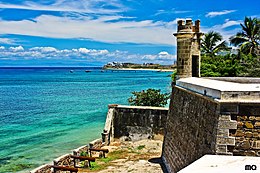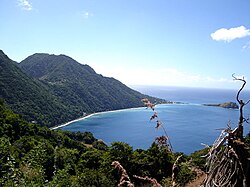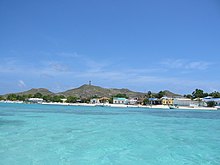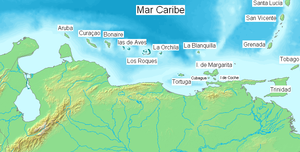Lesser Antilles
| |
|---|---|
 Location within the Caribbean | |
| Coordinates: 14°N 61°W / 14°N 61°W | |
| Region | Caribbean |
| Island States | 24
|
| Area | |
| • Total | 14,364 km2 (5,546 sq mi) |
| Population (2009) | |
| • Total | 3,949,250 |
| • Density | 274.9/km2 (712/sq mi) |
| Demonym | Lesser Antillean |
| Time zone | UTC−4 ( AST) |
| • Summer ( DST) | UTC−3 (ADT) |

The Lesser Antilles [1] are a group of islands in the Caribbean Sea. They are distinguished from the large islands of the Greater Antilles to the west. They form an arc which begins east of Puerto Rico and swings south through the Leeward and Windward Islands almost to South America and then turns west along the Venezuelan coast (Leeward Antilles) as far as Aruba. Barbados is isolated about 100 miles east of the Windwards.
Most of them are part of a long, partially volcanic island arc between the Greater Antilles to the north-west and the continent of South America. [2] The islands of the Lesser Antilles form the eastern boundary of the Caribbean Sea where it meets the Atlantic Ocean. Together, the Lesser Antilles and the Greater Antilles make up the Antilles. (Somewhat confusingly, the word Caribbean is sometimes used to refer only to the Antilles, and sometimes used to refer to a much larger region.) The Lesser and Greater Antilles, together with the Lucayan Archipelago, are collectively known as the West Indies.
The islands were dominantly Kalinago compared to the Greater Antilles which was settled by the Taíno, the boundary set between them is known as the " poison arrow curtain" for the Kalinago's favoured weapon for fending off Europeans that came to conquer the islands in the 16th century. [3]
History after European arrival
The Spanish were the first Europeans to arrive on the islands with the arrival of Christopher Columbus. In 1493, on his second voyage, Columbus reached the coast of the Caribbean Sea, where he sailed to discover several islands of the Lesser Antilles archipelago. He called the first island he discovered on this trip the Deseada. The Spanish claimed the island of Dominica and took solemn possession on the land of the island they called Marigalante. They then anchored next to the island they called Guadeloupe. Later they visited Montserrat, Antigua and San Cristobal. They then crossed the archipelago of the Eleven Thousand Virgins.
Over the next centuries, the Spanish, French, Dutch, Danish and English fought over several of the islands.
Pierre Belain d'Esnambuc was a French merchant and adventurer in the Caribbean, who established the first permanent French colony, Saint-Pierre, on the island of Martinique in 1635. Belain sailed to the Caribbean in 1625, hoping to establish a French settlement on the island of St Christopher ( St Kitts). In 1626 the French under Pierre Belain d'Esnambuc began to take an interest in Guadeloupe, driving out the Spanish colonists.
Martinique was mapped by Columbus in 1493, but Spain had little interest in the territory. Christopher Columbus landed on 15 June 1502 after 21 days of crossing with trade winds, his fastest oceanic journey. On 15 September 1635, Pierre Belain d'Esnambuc, the French governor of the island of San Cristóbal, landed in the port of San Pedro with 80–150 French settlers after being expelled from San Cristóbal by the English. D'Esnambuc claimed Martinique for the French King Louis XIII and the "Compagnie des Îles de l'Amérique".

Margarita Island in present-day Venezuela was discovered on 15 August 1498 during Columbus' third voyage. On that trip the Admiral would also discover the mainland, Venezuela. On that August day, Columbus spotted three islands, two of them small, low and arid (the present day Coche and Cubagua),
The province of Trinidad was created in the 16th century by the Spanish, and its capital was San José de Oruña. But during the Napoleonic Wars, in February 1797, a British force began occupying the territory. And in 1802 Spain recognized the British sovereignty.
In 1917 the United States bought the Danish Virgin Islands. Most of the British colonies became independent states, the islands of the Lesser Antilles belonging to Venezuela were divided into 2 different entities the State of Nueva Esparta and the Federal Dependencies (1938). In 1986 Aruba seceded from the Netherlands Antilles, officially becoming a country of the Kingdom of the Netherlands. In 2010 the rest of the Netherlands Antilles was dissolved to form smaller entities.
On July 18, 1995, the previously dormant Soufrière Hills volcano on the southern part of the island of Montserrat became active. The eruptions destroyed the Georgian-era capital of Montserrat, Plymouth. Between 1995 and 2000, two-thirds of the island's population was forced to flee, mainly to the UK, leaving less than 1200 people on the island in 1997 (rising to almost 5000 by 2016).
The two official French overseas departments are Guadeloupe and Martinique. St. Martin and St. Barthélemy, formerly part of the department of Guadeloupe, have had a separate status as overseas entities since 2007.
Geography

The islands of the Lesser Antilles are divided into three groups: the Windward Islands in the south, the Leeward Islands in the north, and the Leeward Antilles in the west.
The Windward Islands are so called because they were more windward to sailing ships arriving in the New World than the Leeward Islands, given that the prevailing trade winds blow east to west. The trans-Atlantic currents and winds that provided the fastest route across the ocean brought these ships to the rough dividing line between the Windward and Leeward Islands.
The Leeward Antilles consist of the Dutch ABC islands just off the coast of Venezuela, plus a group of Venezuelan islands.
Geological formation
The Lesser Antilles more or less coincide with the outer cliff of the Caribbean Plate. Many of the islands were formed as a result of the subduction of oceanic crust of the Atlantic Plate under the Caribbean Plate in the Lesser Antilles subduction zone. This process is ongoing and is responsible not only for many of the islands, but also for volcanic and earthquake activity in the region. The islands along the South American coast are largely the result of the interaction of the South American Plate and the Caribbean Plate which is mainly strike-slip, but includes a component of compression.
Geologically, the Lesser Antilles island arc stretches from Grenada in the south to Anguilla in the north. The Virgin Islands and Sombrero Island are geologically part of the Greater Antilles, while Trinidad is part of South America and Tobago is the remainder of a separate island arc. The Leeward Antilles are also a separate island arc, which is accreting to South America.
Political divisions

The Lesser Antilles are divided into eight independent nations and numerous dependent and non-sovereign states (which are politically associated with the United Kingdom, France, the Netherlands, and the United States). Over one third of the total area and population of the Lesser Antilles lies within Trinidad and Tobago, a sovereign nation comprising the two southernmost islands of the Windward Island chain.
Sovereign states
| Name | Subdivisions | Area (km2) |
Population (July 1, 2005, est.) |
Population density (per km2) |
Capital |
|---|---|---|---|---|---|
| Antigua and Barbuda | Parishes | 440 | 85,632 | 195 | St. John's |
| Barbuda | 161 | 1,370 | 9.65 | Codrington | |
| Redonda | 2 | 0 | 0 | n/a | |
| Barbados | Parishes | 431 | 284,589 | 660 | Bridgetown |
| Dominica | Parishes | 754 | 72,660 | 96.3 | Roseau |
| Grenada | Parishes | 344 | 110,000 | 319.8 | St. George's |
| Saint Kitts and Nevis | Parishes | 261 | 42,696 | 163.5 | Basseterre |
| Nevis | 93 | 12,106 | 130.1 | Charlestown | |
| Saint Lucia | Districts | 616 | 173,765 | 282 | Castries |
| Saint Vincent and the Grenadines | Parishes | 389 | 110,000 | 283 | Kingstown |
| Trinidad and Tobago | Trinidad | 5,131 | 1,405,953 | 253.3 | Port of Spain |
| Tobago | 300 | 60,000 | 180 | Scarborough | |
| Total | 8,367 | 2,179,295 | 260.5 |

Non-sovereign states and territories
| Name | Sovereign state | Subdivisions | Area (km2) |
Population (July 1, 2005, est.) |
Population density (per km2) |
Capital |
|---|---|---|---|---|---|---|
| Aruba | Kingdom of the Netherlands | Districts | 193 | 103,065 | 534.0 | Oranjestad |
| Anguilla | UK | Districts | 91 | 13,600 | 149.4 | The Valley |
| Bonaire | Netherlands | 288 | 14,006 | 48.6 | Kralendijk | |
| British Virgin Islands | UK | Districts | 153 | 27,000 | 176.5 | Road Town |
| Curaçao | Kingdom of the Netherlands | Districts | 444 | 180,592 | 406.7 | Willemstad |
| Guadeloupe | France | Arrondissements | 1,780 | 440,000 | 247.2 | Basse-Terre |
| Martinique | France | Arrondissements | 1,128 | 400,000 | 354.6 | Fort-de-France |
| Montserrat | UK | Parishes | 120 | 4,655 | 38.8 | Brades |
| Saba | Netherlands | 13 | 1,424 | 109.5 | The Bottom | |
| Saint Barthélemy | France | Paroisses (parishes) | 21 | 7,448 | 354.6 | Gustavia |
| Saint-Martin | France | 53 | 35,000 | 660.4 | Marigot | |
| Sint Eustatius | Netherlands | 34 | 3,100 | 91.2 | Oranjestad | |
| Sint Maarten | Kingdom of the Netherlands | 34 | 40,917 | 1,203.4 | Philipsburg | |
| Spanish Virgin Islands ( Puerto Rico) | United States | Barrios | 165.1 | 11,119 | 67.35 |
Culebra Isabel II |
| United States Virgin Islands | United States | Districts | 346 | 108,448 | 313.4 | Charlotte Amalie |
| Nueva Esparta | Venezuela | Municipalities | 1,150 | 491,610 | 427.5 | La Asunción |
| Federal Dependencies of Venezuela | Venezuela | Federal dependencies | 342 | 2,155 | 6.3 | Gran Roque |
| Total | 5,997 | 1,769,955 | 320.1 |

Several islands off the north coast of Venezuela and politically part of that country are also considered part of the Lesser Antilles. These are listed in the section below.
Islands
The main Lesser Antilles are (from north to south to west):
Leeward Islands

- Anguilla (UK)
- Saint Martin (France) / Sint Maarten (Netherlands)
- Saint Barthélemy (France)
- Saba (Netherlands)
- Sint Eustatius (Netherlands)
- Saint Kitts (St. Kitts and Nevis)
- Nevis (St. Kitts and Nevis)
- Barbuda (Antigua and Barbuda)
-
Antigua (Antigua and Barbuda)
- Redonda (Antigua and Barbuda) uninhabited
- Montserrat (UK)
-
Basse-Terre and
Grande-Terre (often combined as
Guadeloupe) (France)
- La Désirade (Guadeloupe dependency) (France)
- Marie-Galante (Guadeloupe dependency) (France)
- Îles des Saintes archipelago (Guadeloupe dependency) (France)

Windward Islands
- Dominica (Commonwealth)
- Martinique (France)
- Saint Lucia (St. Lucia)
- Saint Vincent (St. Vincent and the Grenadines)
- Grenadines (St. Vincent and the Grenadines)
- Carriacou and Petite Martinique (Grenada)
- Grenada (Grenada)
Leeward Antilles


Islands north of the Venezuelan coast (from west to east):
- Aruba (Netherlands)
- Curaçao (Netherlands)
- Bonaire (Netherlands)
- Federal Dependencies of Venezuela (Venezuela)
- Nueva Esparta (Venezuela)
Isolated islands in the Lesser Antilles
† Physiographically, these are continental islands not part of the volcanic Windward Islands arc. However, based on proximity, these islands are sometimes grouped with the Windward Islands culturally and politically.
- ^ Barbados is a Continental island found 100 miles (160 km) east of the Windward chain.
- ^ Sometimes considered part of the Windward Islands. They are the most southern islands of the Caribbean region. See Islands of Trinidad and Tobago.
See also
- Lesser Antilles Volcanic Arc
- Greater Antilles
- Lucayan Archipelago
- Organisation of Eastern Caribbean States
References
- ^ (Spanish: Antillas Menores; French: Petites Antilles; Papiamento: Antias Menor; Dutch: Kleine Antillen)
- ^ a b "West Indies." Merriam-Webster's Geographical Dictionary, 3rd ed. 2001. ( ISBN 0-87779-546-0) Springfield, MA: Merriam-Webster Inc., p. 1298.
- ^ Floyd, Troy S. (1973). The Columbus Dynasty in the Caribbean, 1492-1526. University of New Mexico Press. p. 135.
- ^ "Windward Islands | islands, West Indies". Encyclopedia Britannica. Archived from the original on May 2, 2015. Retrieved January 18, 2019.
- ^ Centre, UNESCO World Heritage. "The Scotland District of Barbados". UNESCO World Heritage Centre. Archived from the original on July 19, 2018. Retrieved January 18, 2019.
- ^ "The Windward Islands and Barbados". countrystudies.us. Archived from the original on October 12, 2011. Retrieved January 18, 2019.
- ^ Cohen, Saul B., ed. "West Indies" Archived August 16, 2006, at the Wayback Machine The Columbia Gazetteer of North America. Archived August 20, 2006, at the Wayback Machine New York: Columbia University Press – Bartleby. Accessed: September 19, 2006
- ^ ARBITRAL TRIBUNAL CONSTITUTED PURSUANT TO ARTICLE 287, AND IN ACCORDANCE WITH ANNEX VII, OF THE UNITED NATIONS CONVENTION ON THE LAW OF THE SEA IN THE MATTER OF AN ARBITRATION BETWEEN: BARBADOS – AND – THE REPUBLIC OF TRINIDAD AND TOBAGO Archived December 17, 2008, at the Wayback Machine – The Hague, April 11, 2006 (Pages 15–16)
Bibliography
- Rogonzinski, Jan. A Brief History of the Caribbean. New York: Facts on File. 1992. ISBN 978-0816024513.
External links
-
 Media related to
Lesser Antilles at Wikimedia Commons
Media related to
Lesser Antilles at Wikimedia Commons -
 The dictionary definition of
Lesser Antilles at Wiktionary
The dictionary definition of
Lesser Antilles at Wiktionary - The Lesser Antilles Island Arc: Structure And Geogynamic Evolution